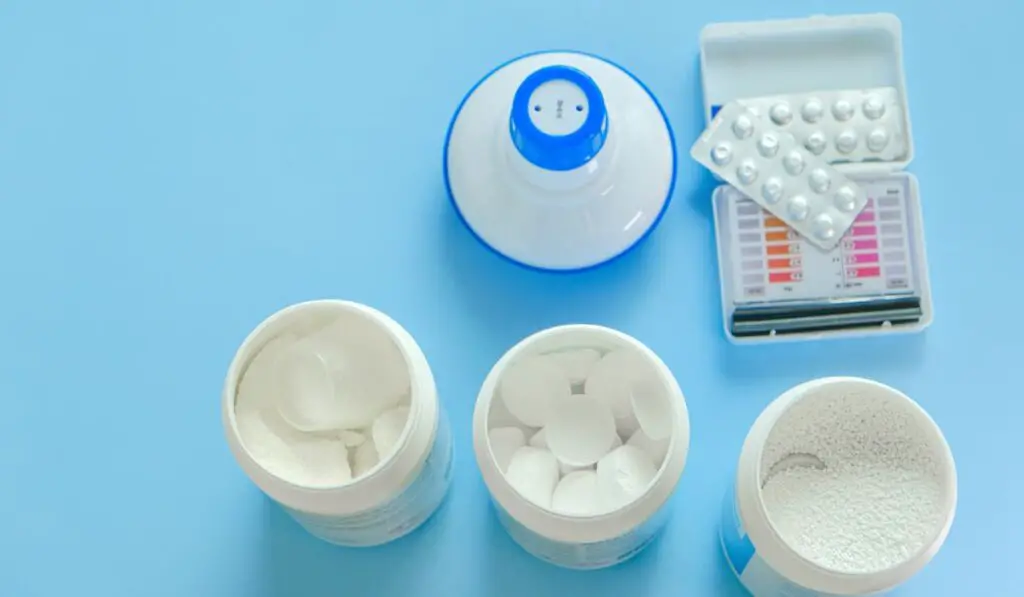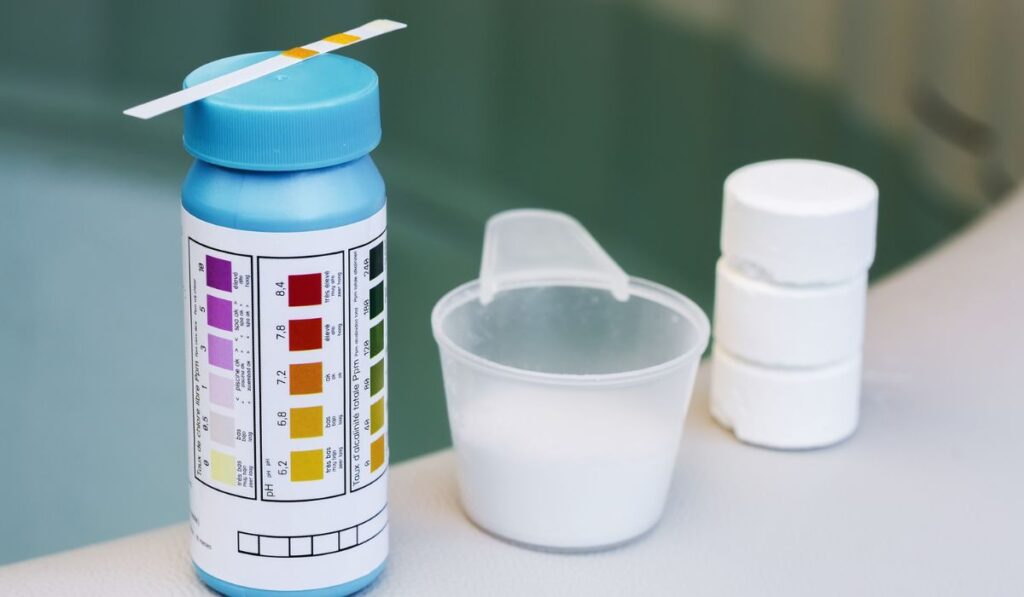Owning a hot tub or pool likely means you know all about chlorine. It is the most common product used for water sanitization. However, have you heard about bromine?
Bromine and chlorine are the best products to use for hot tub sanitization. Chlorine is cheaper but also a harsher chemical that can be rough on the skin. Bromine treatment contains fewer chemicals, making it better for your skin, but it is more expensive and takes time to bring the water to safe levels.
Not sure which chemical is best for your hot tub? Let’s look at the differences between the two so you can get an idea of which chemical to put in your hot tub.
What’s the Difference Between Bromine and Chlorine for Hot Tubs?

Knowing the difference between bromine and chlorine is essential to ensure the correct sanitization level for your hot tub.
They’re similar, but the differences between them are more obvious when using them in hot tubs. This is primarily due to high temperature levels, which causes the chemicals to react differently than they normally would.
Both are halogens and sit close together on the periodic table of elements. Halogens are dangerous chemicals, which means both pose threats to the human body when in use. If someone is careless with these chemicals, they can harm the skin, eyes, body, and more.
Popularity
Bromine is typically sold into two compounds for personal use as it is far too reactive in its natural state. The two compounds bromine is formed into are sodium bromide (NaBr) and potassium bromide (KBr), both of which can be found in seawater.
Bromine is a lot less popular than chlorine. Chlorine is the popular choice as it is cheaper. Yet, with the amount of chlorine you need to use to ensure your water is at the correct pH level, it could be cheaper to use bromine.
Available Forms
For hot tub use, chlorine comes in various forms, including tablets, liquid, and dry powders. Bromine typically comes in granules and tablets. Both should be dispersed in water, and both tablet versions are popular as they dissolve quickly.
Reaction Speed
Although both chemicals assist with water sanitization, they do work differently. Bromine is slower to react, which is likely from it being manufactured into a less potent product for safety purposes.
Chlorine works immediately to dissipate and attack germs and kill off bad bacteria. Yet, once it has done its job, it leaves behind chloramines, which we all know as the intense smell that accompanies chlorinated water. This can harm the skin, leaving it red, sore, and itchy. Chloramines eventually decrease the overall efficacy of the chlorine, meaning it isn’t useful for very long.
Bromine works through an ionization process that does the same job, yet it might be slower. It has a much lower pH level than chlorine, making it gentler on the skin and longer lasting. Due to the difference in pH level, bromine is much more stable than chlorine. This helps it work longer and does not need constant adjusting. Hence, bromine can be more convenient.
Which Is Healthier, Chlorine Or Bromine?
When used correctly, chlorine and bromine are safe for human use. Using the correct dosages will ensure you avoid any adverse reactions. However, chlorine is known to be harsher on the skin, which can make it more dangerous for other parts of the body too. For instance, chlorine can cause more irritation to the eyes than bromine.
In particular, chlorine can cause skin problems. Chlorine can be especially irritating for people with sensitive skin. Its high pH level can trigger water loss and inflammation, making the skin dry, red, sore, and itchy.
Bromine is a popular alternative for those with sensitive skin or anyone wishing to avoid skin problems when using their hot tub. Its lower pH level makes it kinder to the skin. It is less abrasive and doesn’t smell as potent, making it much nicer to use in a calm, relaxing space like a hot tub.
It is common for bromine to leave a bleach-like odor on the skin after sitting in a hot tub for a long time. This can be more challenging to scrub off and remove than chlorine. Yet, the smell is subtle and will not lead to skin irritation.
Therefore, overall, Bromine can be considered the healthier option as it is kinder to the skin and less harmful for those with sensitivities.
What Happens if You Mix Bromine and Chlorine in a Hot Tub?

Combining bromine and chlorine in any water shouldn’t be done under any circumstance. When the two chemicals mix, they become extremely potent. Not only can the mixture cause skin damage, but it can also erode pipes and hot tub equipment and cause excessive wear to the hot tub materials.
It is important to drain your hot tub and scrub it thoroughly if you wish to change from one sanitizer to another. Ensuring not to mix them helps you avoid dangerous reactions and poor health effects.
Is Bromine More Expensive Than Chlorine?
Most people choose to use chlorine over bromine because it is slightly cheaper. On average, chlorine is 20% cheaper than bromine.
Yet, over time, bromine could be cheaper than chlorine. Chlorine typically has a shelf life of one year. After that, it will lose its efficacy. At the same time, bromine has a much longer shelf life. Therefore, if you plan on using a hot tub sanitizer for years, you will be better off investing in bromine so that it doesn’t lose its efficacy if you do not use it regularly.
Is It OK to Switch From Bromine to Chlorine?
Whether you currently use chlorine or bromine, switching from one to the other is okay. But you must be careful as they can become dangerous when mixing. Therefore, emptying the hot tub, cleaning it thoroughly, and taking other measures during the switch is essential. If you do not take the correct measures, you could cause damage to your skin as well as the hot tub.
You must wait until the bromine level in the hot tub is reduced before you decide to switch. If you try switching from bromine to chlorine straight after adding more bromine to your hot tub, you will have a more challenging task.
We recommend waiting until the bromine level has gone down to the point where you would need to add more; then, you can decide to switch from one sanitizer to the other.
When the bromine level is low, you should empty the hot tub and clean it thoroughly. The next step is to change the brominator to a chlorinator, as chlorine requires a chlorinator to ensure maximum dissolving capacity and minimal bacteria.
Then you can follow the directions on your product to add the chlorine in the correct amounts into your hot tub. Never just add chlorine to water which contains bromine.
How Much You Need To Use
Using the ideal level for each sanitizer is essential to avoid damage to the skin and the hot tub materials. The correct amount of bromine is between 3 and 5 ppm (parts per million). For chlorine, is it advised to use 1.5 to 3 ppm. You can use these guidelines for most hot tubs, regardless of size.
In most cases, it is advised to choose the higher end of the spectrum when adding either sanitizer. Doing so will guarantee more sanitization and efficacy. You will also find that you need to use more bromine than chlorine, almost double. However, bromine lasts longer, so you won’t be topping it up as often.
Keep in mind that chlorine works faster than bromine. Bromine is as efficient and effective as chlorine, but the chemicals in chlorine react slightly faster when added to water. However, bromine works for longer. Even when bromine is added to warm water, it will last longer than chlorine. Chlorine can work in warm water but is less effective.
Hence, it is the better option, with bromine lasting longer, more efficient in warm water, and more stable. Using it as an alternative to chlorine in your hot tub might see you attain easier pH levels and reduce your testing and maintenance process.
Maintaining Chlorine/Bromine Levels
Whichever sanitizer you choose, ensure to cover your hot tub when it isn’t in use. Doing so will ensure the chemicals and water are protected from UV rays, which can reduce the sanitizer’s efficacy.
It can be trickier to maintain the pH level of chlorine as it is less stable, especially in the sunlight. With it being difficult to maintain, it is important to test it regularly. Once you achieve the correct pH level, add two tablespoons every two or three days, which should keep it at the correct level.
If there is more or less sanitizer than these recommended levels in your hot tub, it is advised to correct it before using it. This will ensure your safety and that you are using efficiently sanitized water.
